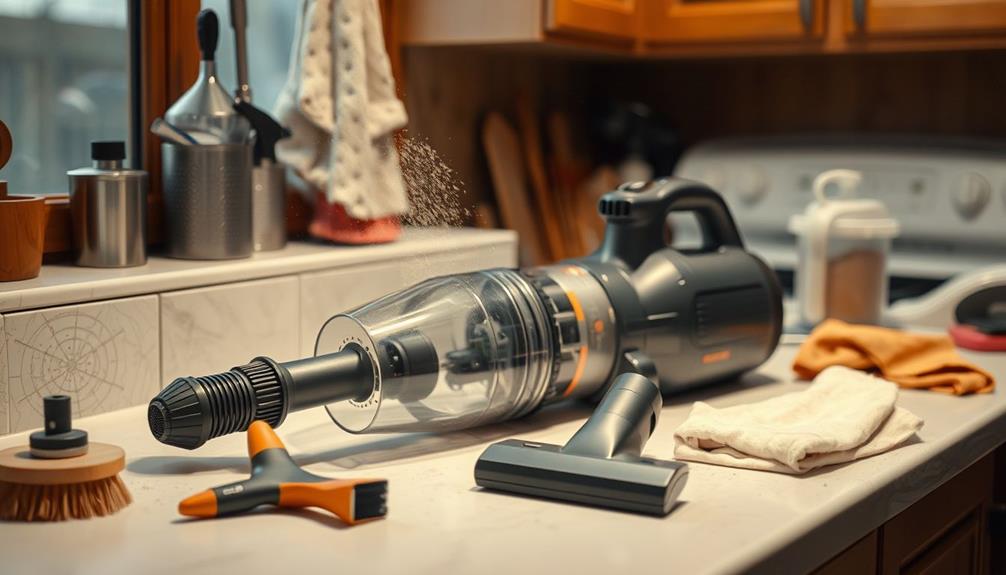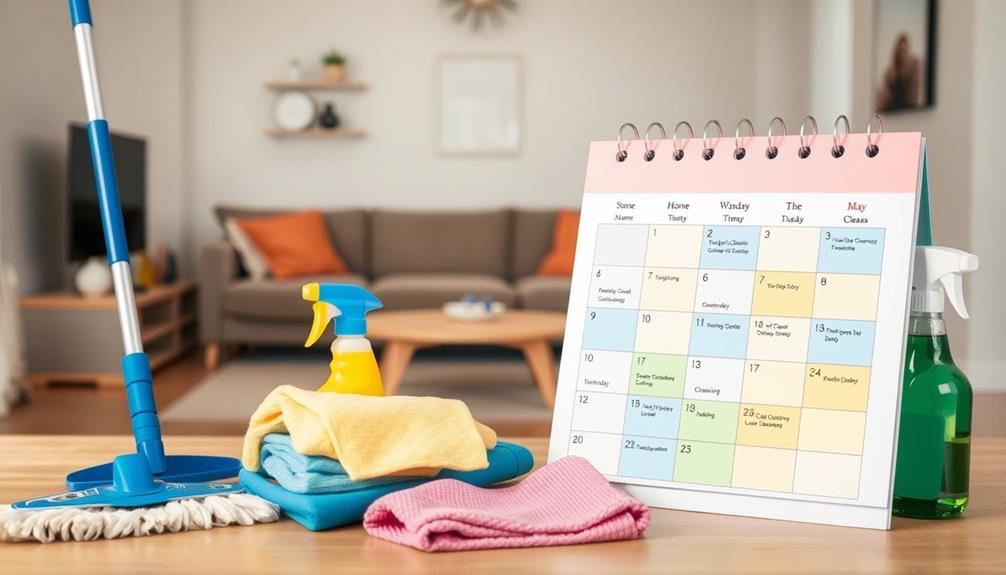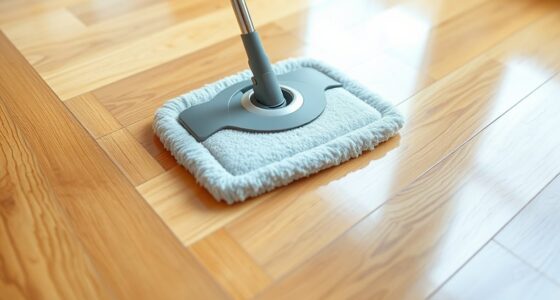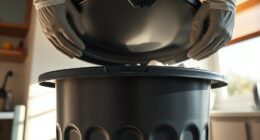To ensure your vacuum cleaner functions smoothly, remember to unplug it before performing maintenance and start by addressing the bag or canister. Swap out bags when they reach two-thirds full and empty canisters after each use. Take a moment to inspect filters on a monthly basis, cleaning washable ones and replacing non-washable filters every 6-12 months. Check the brush roll for hair and debris, cutting away any tangles that may have formed. Regularly inspect all hoses and pathways for blockages, and clean the exterior and wheels to improve maneuverability. By adhering to these straightforward maintenance suggestions, you’ll be able to prolong the life of your vacuum and optimize its performance. For more helpful maintenance tips, visit this link! When it comes to maintaining your robot vacuum, remember to regularly check and clean the sensors to ensure smooth navigation and effective performance. Also, remember to remove and clean the dustbin after each use to prevent clogs and maintain suction power. By following these maintenance tips for both traditional and robot vacuums, you can extend the life of your appliances and keep your floors spotless effortlessly.
Key Takeaways
- Regularly check and replace vacuum bags or empty the dust canister after each use to maintain optimal suction power.
- Inspect and clean filters monthly; replace non-washable filters every 6-12 months to enhance air quality.
- Clean the brush roll and base monthly, removing hair and debris to ensure efficient performance and prevent overheating.
- Check hoses and internal pathways for blockages regularly; use tools like coat hangers to dislodge clogs for better airflow.
- Wipe down the vacuum's exterior and clean wheels frequently to improve maneuverability and maintain hygiene.
Safety Precautions
Before diving into cleaning your vacuum cleaner, make certain you prioritize safety. First, always unplug your vacuum before performing any maintenance. This step is vital to prevent accidental start-up, which could lead to injuries.
Next, take a moment to check for the presence of a ground prong on the vacuum's plug. If it's missing, it's best to contact the manufacturer for repairs to avoid unsafe usage. Additionally, if you own a vacuum designed for pet hair removal, like the Bissell Pet Hair Eraser, verifying it's unplugged will help you safely clean the self-cleaning brush roll technology.
Never attempt to conduct maintenance while your vacuum is turned on. Doing so increases the risk of accidents and injuries.
Also, confirm your work area is free of tripping hazards, like loose cords or debris, to maintain a safe environment while you clean.
Bag and Canister Maintenance

Keeping an eye on your vacuum's bag or canister is essential for maintaining its performance. Regular maintenance can enhance the lifespan of your vacuum, guaranteeing it operates efficiently for years to come.
If you have a bagged vacuum, replace the bag when it's about two-thirds full to guarantee peak suction. For bagless models, empty the dust canister after each use and clean it regularly to prevent odors and buildup.
Consider using a vacuum suitable for effective performance that aligns with your cleaning needs.
Monitor Bag Fullness
Monitoring the fullness of your vacuum's bag or dustbin is essential for maintaining its performance. If you use a bagged vacuum, aim to replace the vacuum bags when they're about 2/3 full. This practice helps maintain peak suction and efficiency during operation.
For bagless models, make it a habit to empty the dustbin after each use. Overfilling can lead to decreased suction and messy clean-ups. Additionally, using a quality vacuum cleaner can greatly impact your cleaning efficiency and satisfaction, similar to how the best laundry detergents enhance the washing experience.
Keep an eye on bag fullness to prevent overheating and motor strain caused by restricted airflow. If you notice a drop in suction power or debris reappearing on surfaces after cleaning, it's likely time to check the bag or dustbin. Regularly monitoring bag fullness not only enhances your vacuum's efficiency but also extends its lifespan.
For best results, change vacuum bags every three months, or more frequently if you use your vacuum heavily or have a higher capacity model. A little diligence in monitoring bag fullness can go a long way in keeping your vacuum running smoothly and effectively.
Clean Dust Canister Regularly
Cleaning your dust canister regularly is vital for maintaining your vacuum's performance. If you have a bagless vacuum, make it a habit to empty your dust canister after each use. This prevents overfilling, which can lead to decreased performance and messy disposal.
Additionally, it's important to evaluate what to look for in a home cleaning service to guarantee you have the right tools and support for your cleaning needs.
To keep your canister in peak shape, clean it with warm, soapy water. After washing, verify it's completely dry before reattaching it to your vacuum. This step helps prevent odors and mold growth, keeping your vacuum cleaner fresh.
In addition to cleaning, you should also inspect your dust canister regularly for cracks or damage. Any imperfections can compromise its ability to seal properly, negatively impacting suction efficiency.
If you notice any issues, it's best to replace the canister to guarantee maximum performance.
Filter Care
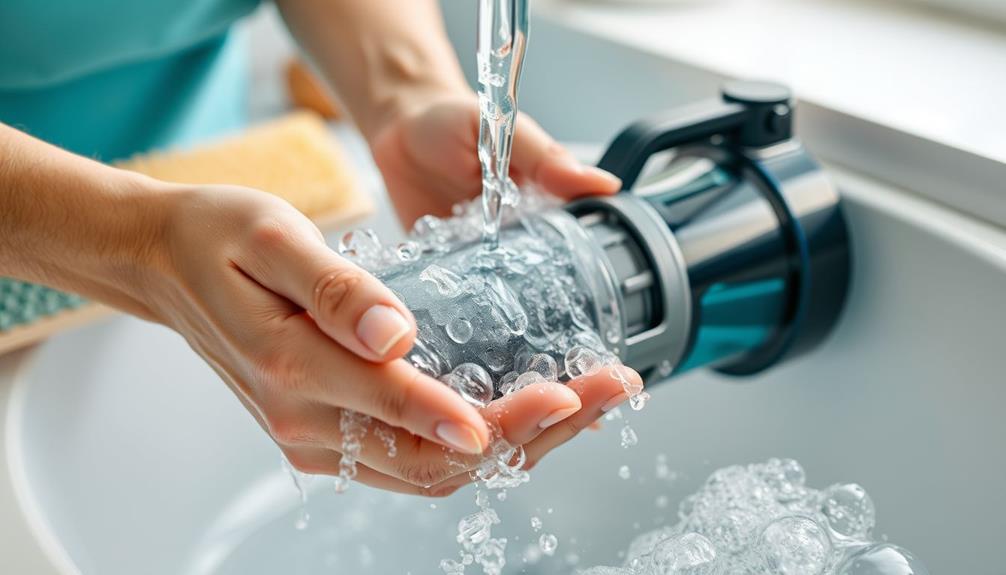
Maintaining your vacuum cleaner's filters is crucial for best performance and air quality. Regular filter care helps prevent clogs and keeps your vacuum running smoothly. Check your filters—HEPA, foam, and felt—at least once a month for any dirt buildup that could impact suction.
Additionally, just like using ozone air purifiers helps eliminate allergens, verifying your vacuum filters are clean can greatly enhance the air quality in your home.
For washable filters, rinse them with cold water and allow them to air dry completely before reinstalling. Wet filters can harbor mold and bacteria, which can worsen air quality. If your filters are non-washable, remember to replace them according to the manufacturer's guidelines, typically every 6-12 months. This guarantees consistent airflow and filtration efficiency.
Before washing, gently tap your filters against a hard surface to remove dust. Avoid using soap unless the manufacturer specifies it's safe, as this could damage the filter.
A clean HEPA filter greatly improves indoor air quality by capturing smaller particles, making regular maintenance crucial, especially for those with allergies or respiratory issues. By staying on top of filter care, you enhance your vacuum's effectiveness and prolong its lifespan.
Brush Roll Cleaning

To keep your vacuum running smoothly, regularly inspect the brush roll for hair and debris.
It's essential to remove any tangled mess to maintain peak performance. A well-maintained brush roll not only boosts suction but also prolongs the life of your vacuum.
Additionally, ensuring that your vacuum cleaner is free from obstructions can enhance its efficiency, similar to how garage door openers improve home security with advanced features.
Regular Inspection Schedule
While it might seem tedious, regularly inspecting the brush roll of your vacuum cleaner is vital for peak performance. Cats can exhibit separation anxiety when their environment changes, leading to behaviors that may require additional cleaning efforts around the home. So, aim to check it at least once a month to remove any debris that can hinder suction and overall effectiveness.
Hair, string, and other dirt and debris can get tangled in the brush, affecting its rotation and your vacuum's performance. When you inspect the brush roll, carefully use scissors or a seam ripper to cut away any entangled materials.
Don't forget to check the ends of the brush roll near the bearings and belt engagement area, as this is where debris often accumulates. A clean brush is essential for maintaining ideal dirt and debris extraction, guaranteeing your vacuum runs smoothly.
Neglecting this aspect of vacuum cleaner maintenance can lead to reduced suction power and even overheating, which can shorten the life of your appliance. By incorporating a regular inspection schedule, you'll not only extend the life of your vacuum but also make sure it performs at its best, keeping your home clean and dust-free.
Debris Removal Techniques
After setting up a regular inspection schedule, it's time to focus on effective debris removal techniques to keep your brush roll clean and functioning well.
A clean brush roll is essential for maintaining peak suction power and guaranteeing your vacuum performs at its best. Additionally, keeping your environment free of certain plants can prevent issues that might distract you from regular maintenance environmental factors affecting cats.
Here are three key steps to follow:
- Inspect and Cut: Regularly check the brush roll for hair, string, or other debris that can hinder its performance. Use scissors or a seam ripper to carefully cut away any tangled materials, allowing the brush roll to spin freely.
- Clean Thoroughly: Use a grout brush and a damp microfiber cloth to clean the brush roll and base plate. This removes built-up dirt and helps maintain the overall performance of your vacuum filters.
- Check Bearings: Don't forget to inspect the ends of the brush roll near the bearings. Remove any debris that could affect movement and confirm all components are functioning properly.
Air Pathway Inspection
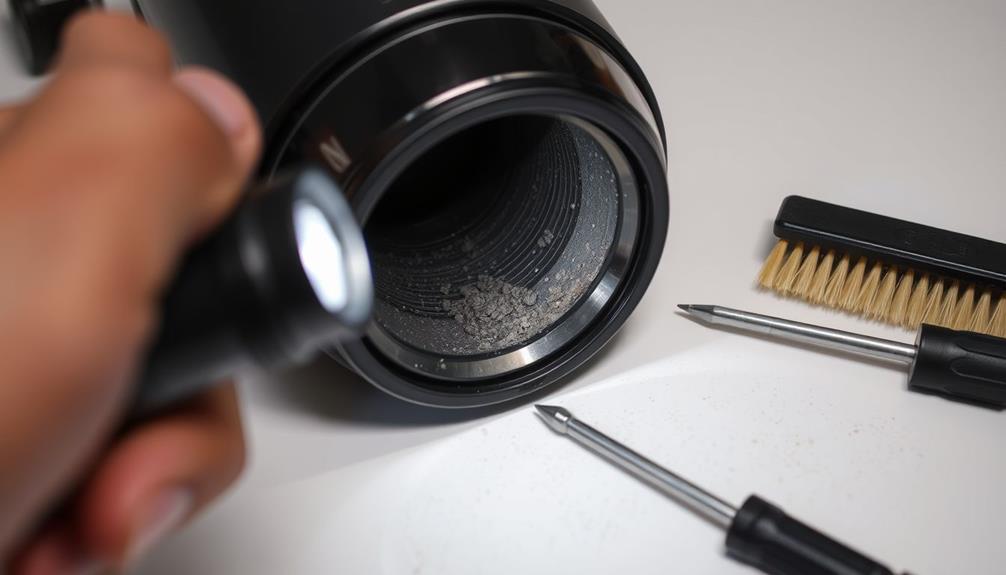
Inspecting the air pathways of your vacuum cleaner is vital for maintaining peak performance. Regularly check the vacuum hoses, attachments, and internal air pathways for blockages. Any obstruction can impede airflow and reduce suction power, making your cleaning efforts less effective.
Additionally, keeping an eye on the vacuum's efficiency can help you avoid higher energy costs associated with neglected appliances, as stated in energy consumption of appliances.
To clean these areas thoroughly, you can use a straightened coat hanger or a long flexible brush to dislodge any clogs in the internal air passages. This step is important, as blockages can lead to overheating and potential burnout of your vacuum.
Don't forget to inspect vent covers as well; clean them regularly to prevent dirt buildup that can reduce vacuum efficiency.
Additionally, verify all connections are secure. Loose attachments can cause suction loss, further decreasing your vacuum's overall cleaning performance.
Exterior and Wheel Cleaning

To keep your vacuum cleaner in top shape, regular exterior and wheel cleaning is essential. Not only does this maintenance enhance its appearance, but it also extends its longevity by preventing corrosion and wear from accumulated dirt.
Incorporating a cleaning routine similar to maintaining your window treatments can help keep your home environment fresh and tidy. Here's how to thoroughly clean your vacuum:
- Clean the Wheels: Use scissors to remove any debris stuck in the wheels. Then, wipe them down to prevent dirt and hair buildup, which can hinder maneuverability.
- Wipe the Exterior: Grab a damp cloth and clean the vacuum's exterior, including the handle and buttons. This not only makes it look better but also maintains hygiene during use.
- Disinfect High-Touch Areas: Use a mild soap solution or disinfectant wipes to clean the handle and control buttons. This helps reduce the spread of germs, keeping your home healthier.
Frequently Asked Questions
How Can I Extend the Life of My Vacuum?
To extend the life of your vacuum, regularly inspect and clean the brush roll to prevent clogs.
Change the vacuum bags when they're 70-80% full for ideal airflow, and clean or replace filters as needed.
Don't forget to schedule professional servicing at least once a year to catch any potential issues early.
Also, store your vacuum in a dry area and keep the cords untangled to avoid wear and tear.
How Can I Make My Vacuum Last Longer?
To make your vacuum last longer, you need to establish a regular maintenance routine.
Clean or replace filters every 1-3 months based on usage, and empty the dustbin after each use.
Inspect the brush roll monthly, removing hair and debris.
Check hoses for blockages periodically, and consider professional servicing once a year.
These steps help maintain peak performance, prevent overheating, and ultimately extend the life of your vacuum cleaner.
How to Properly Maintain a Vacuum Cleaner?
When it comes to vacuum maintenance, you can't afford to let dust bunnies take over.
Start by checking the brush roll monthly for hair and debris, and clean or change bags when they're 70-80% full.
Inspect filters every three months, and clear any blockages in hoses using flexible tools.
Don't forget to schedule professional servicing yearly.
What Is the Average Lifespan of a Vacuum Cleaner?
The average lifespan of a vacuum cleaner usually ranges from 5 to 10 years.
If you've got a bagged model, it might last even longer since it experiences less strain on the motor.
Regular maintenance, like cleaning out filters and brush rolls, can help your vacuum last longer too.
Investing in a high-end model could extend its life to 15 years with proper care.
Conclusion
Keeping your vacuum cleaner in top shape is essential for its longevity and performance. Did you know that a well-maintained vacuum can last up to 15 years, compared to just 5 years for neglected models? By regularly cleaning the bag or canister, filters, and brush rolls, you not only improve its efficiency but also save money in the long run. So, make these maintenance tips a part of your routine, and enjoy a cleaner home for years to come!
